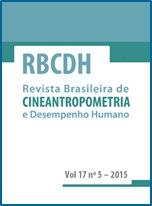Relationship of kimono grip strength tests with isokinetic parameters in jiu-jitsu athletes
DOI:
https://doi.org/10.1590/1980-0037.2015v17n5p575Resumen
The aim of the present study was to correlate two specific kimono grip strength tests (KGST) with elbow flexors and extensors isokinetic parameters in Jiu Jitsu (JJ) athletes. Fifteen male JJ athletes, from blue to black belt, participated in the study. The two KGST were: maximum static lift (MSL), and maximum number of repetitions (MNR), both gripping a kimono wrapped around a bar. Isokinetic tests consisted of three sets of 5 s elbow flexion-extension maximum voluntary isometric contraction (MVIC) in three different elbow angles (45, 90 and 120°), and two sets of five concentric-eccentric elbow flexion-extension maximum dynamic contractions at 60°·s-1, to determine peak torque (PT). Absolute values of MSL and MNR were 41.4 ± 16.2 s and 10 ± 5 reps, respectively, and tests presented a nearly perfect correlation among them (r=0.91; p<0.001). Significant correlations were reported between MNR and PT during MVIC for elbow flexors at 45° and 90°, elbow extensors at 120°, and during concentric and eccentric dynamic contractions for both flexors and extensors. Therefore, KGST were highly correlated with isokinetic parameters, and were nearly perfect correlated among them, supporting that one of the tests could be chosen to evaluate strength in JJ athletes. The MNR test presented apparently higher levels of relation than MSL, and provided significant information about muscle strength endurance in JJ athletes
Descargas
Publicado
Número
Sección
Licencia

Direitos Autorais para artigos publicados nesta revista são do autor, com direitos de primeira publicação para a revista. Em virtude da aparecerem nesta revista de acesso público, os artigos são de uso gratuito, com atribuições próprias, em aplicações educacionais e não-comerciais, desde que seja dada a atribuição. Esta obra foi licenciada com uma Licença Creative Commons Atribuição 4.0 Internacional - CC BY


